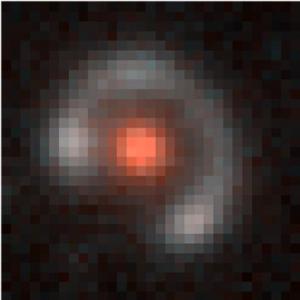Jun 3 2016
A multinational team of astronomers have found a new Einstein Ring, a rare image of a distant galaxy lensed by gravity. The scientists, from Spain, Italy and the USA, report their discovery in Monthly Notices of the Royal Astronomical Society.
 In this colour composite image, the central lensing galaxy is shown in red and the blue Einstein ring, the distorted image of a distant galaxy, is visible all around it. Credit: Bettinelli et al., DECam (Blanco 4-m telescope at CTIO)
In this colour composite image, the central lensing galaxy is shown in red and the blue Einstein ring, the distorted image of a distant galaxy, is visible all around it. Credit: Bettinelli et al., DECam (Blanco 4-m telescope at CTIO)
In his seminal general theory of relativity published a century ago, Albert Einstein predicted that gravity would distort the fabric of spacetime, and that light would follow curved paths as a result. Astronomers first observed this effect in 1919, by measuring the position of stars near the Sun during the 1919 total solar eclipse, and noting a slight shift resulting from the gravitational field of our nearest star. On a larger scale, light from distant galaxies is bent by black holes and massive galaxies that lie between them and the Earth. The intervening objects act as lenses, creating arcs and ‘Einstein rings’ of light.
These rings are still comparatively rare and usually appear as small features in the sky. This makes them hard to see clearly, and most are observed with radio telescopes, or with the Hubble Space Telescope. Their rarity derives from the huge distances involved, and the low probability of our Galaxy, the lens galaxy and the distant galaxy all being almost exactly in line.
The newly discovered ring lies in the direction of the constellation of Sculptor in the southern sky. Margherita Bettinelli, a PhD student at the Instituto de Astrofisica de Canarias, found it while looking at archive images from the Dark Energy Camera (DECam) mounted on the Victor Blanco 4-m telescope at the Cerro Tololo Inter-American Observatory in Chile. Margherita and her team named the ring 'Canarias', in homage to the work carried out by astronomers on La Palma and Tenerife.
Light arriving at the Earth today left the Einstein ring 8 billion years ago, so we see the ring as it was 5 billion years after the Big Bang. Despite its relatively small apparent size (it stretches across an angle on the sky of 4.5 arcseconds or about 1/800th of a degree), it is larger than most of the other rings found to date. Follow up work with the 10.4-m Gran Telescopio Canarias (GTC) confirms its distance and shows that the intervening lens galaxy has a mass equivalent to around a trillion (million million) Suns.